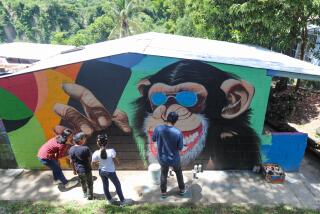Many See Red Over Idea for Green Space
SAN SALVADOR — New York has Central Park. Los Angeles has Griffith Park. Mexico City has Chapultepec and San Salvador has . . . well, San Salvador has no major park to get away from city bustle.
The city has grown out toward its suburbs like a bulldozer, plowing down everything in its path and drawing 16 cities into an indistinguishable urban sprawl of 1.5 million people. Even former parks have been converted into de facto marketplaces in this densely populated metropolis, capital of the second-most deforested country in the Americas, after Haiti, as measured by the percentage of forested land remaining.
So, Mayor Mario Valiente’s proposal that part of San Salvador’s last big expanse of rural land be converted into a park might have made him highly popular. Instead, the idea has pitted farmers, developers and environmentalists against each other in a controversy that spilled into violence last month when riot police were called out to quell a demonstration.
Cooperative farmers want to continue growing coffee on the land. Environmentalists insist that the entire plantation should be a nature reserve and that even the farmers’ use of the land should be controlled because its aquifers provide 10% of San Salvador’s water. Developers reviving an old property claim are eager to convert a part of the rural land next to the proposed park into a $100-million luxury development.
The conflict illustrates the difficulty of preserving green space in impoverished, densely populated nations.
“Our country is small, so even small amounts of land mean a lot to us,” said Luis Mata of the Salvadoran Appropriate Technology Center, one of several environmental groups opposed to park plans. With only 2% of the natural forest left, so-called secondary forests mean a lot.
Those secondary forests include Finca El Espino, named for a flowering bush, a coffee plantation four times the size of Disneyland that separates the 422,570 residents of San Salvador proper from the 116,575 residents of rapidly growing Santa Tecla. During the 1980 agriculture reform--part of the futile attempts to avoid the 12-year civil war that ended in 1992--the plantation was confiscated from the powerful Duenas family and given to their workers, who formed a cooperative. The Duenas family received $4 million in compensation.
In 1987, with a conservative government in power, the Supreme Court ruled that part of the land had been illegally expropriated and should be returned. A government commission decided in 1991 that a swath of land next to San Salvador’s most exclusive residential area should be returned to the Duenas family and that 865 acres would be turned into a reserve. The cooperative’s 550 families could continue to farm about 700 acres.
Environmentalists and farmers were furious. Their anger rose when the mayor announced plans for a park in 1995, and again when a development project was unveiled for the Duenas family portion of the land.
The Duenas family representative could not be reached for comment. City hall staffers said the mayor is busy campaigning for reelection and did not have time to discuss the park proposal.
The 700 acres being left to the cooperative is the poorest, driest land on the farm, said Ricardo Orellano, president of the cooperative. It will not provide a living for the members of the cooperative.
People other than the cooperative members will be harmed by the proposed development and park, environmentalists warn.
“We are talking about what is in the interests of everyone, not just a few people,” said Roxana Garcia, a member of the Committee to Rescue El Espino. Citing a 1972 study the Salvadoran water authority commissioned, she added: “That land should not be touched.”
The study found that El Espino’s rich, volcanic soil is a perfect filter and storage area for processing 186 million cubic feet of water a year, an increasingly scarce commodity for San Salvador’s growing population, she said.
In addition, Garcia said, El Espino acts as the capital’s lungs, helping to clean the air in what a recent study described as Central America’s most polluted city. Thousands of plants and 162 species of birds, including rare parakeets, live on the farm. The park would cause problems because of its parking lots, restrooms and restaurants, along with the hundreds of people a day who could be drawn to the area, she added.
The Committee to Rescue El Espino has filed suit with the Supreme Court to halt development. Still, early this year, city officials built a fence around the portions marked for development and the proposed park.
Despite the environmentalists’ opposition to development, members of the cooperative found themselves alone when they marched out to tear the fence down. They were tear-gassed by police; at least one man was arrested for throwing rocks.
“The environmentalists want us to stand firm, not to negotiate with the government,” Orellano said. “But we cannot do this alone. We are just poor farmers. We are going to have to negotiate.”
More to Read
Sign up for Essential California
The most important California stories and recommendations in your inbox every morning.
You may occasionally receive promotional content from the Los Angeles Times.










